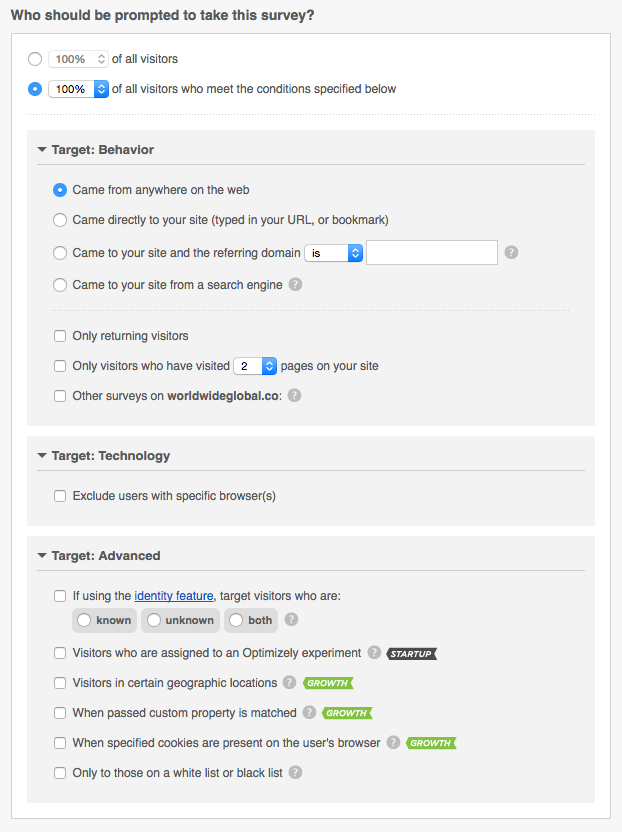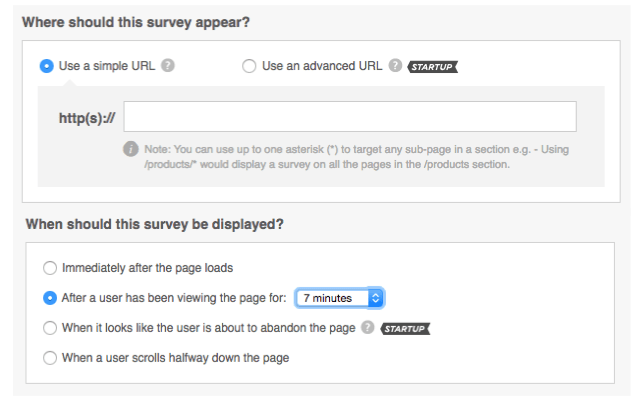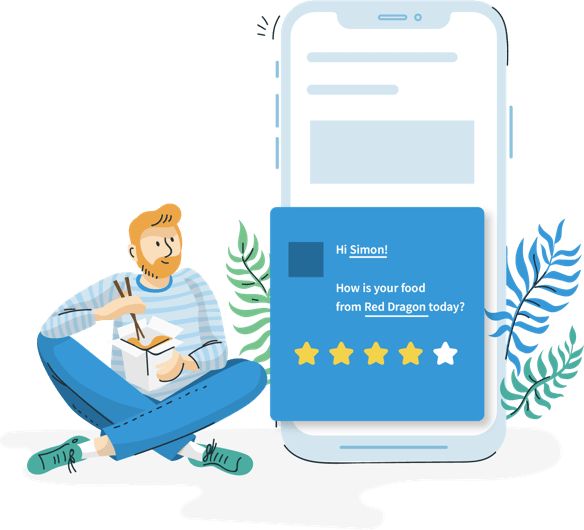Any startup founder worth their salt knows you can’t build a successful business in a vacuum. If you aren’t talking to your customers, you’ll have no idea how to build something they’ll actually use, or the best way to distribute it to them.
But collecting customer feedback can feel overwhelming.
Where do you even start? Calling your customers might work great in the early days when you’ve only got 50 or so, but it’s not sustainable as you grow. To make feedback an ongoing part of your business, you need a way to ask your customers the right questions at the right time and track their responses at scale.
That’s exactly what customer survey platforms like Qualaroo let you do. But while those automated surveys are the answers you’re looking for, they won’t get you results without a focused plan and some work up front. Here are three best practices for getting started with Qualaroo.
1. Choose a Survey Based on Your Goals
When you can automate surveys, you might be tempted to ask your customers as many questions as you can. The more feedback, the better, right?
Not quite. That approach is too haphazard. You need to go in with a plan based on specific parts of the customer experience you think your users can help you improve. Work backwards from the customer insights you want to uncover and figure out what questions will surface from them.
A survey for every objective
Luckily, there’s a survey out there for any goal you can think of. Here are the surveys Qualaroo customers have used to get customer feedback around specific objectives:
- Want feedback on your product? Try a Net Promoter Score (NPS) survey. There’s a reason high NPS scores have been linked to growth. NPS cuts to the heart of the customer experience by asking customers point blank if your product is valuable enough to recommend to others, then lets them tell you how to improve.
- Want to pinpoint your most valuable ad channels? Use this survey to ask site visitors and new customers how they heard about you. That way, you can double down on the channels filling the top of your acquisition funnel.
- Want to solve e-commerce cart abandonment? Use an exit survey to find out why users are leaving your store without buying anything.
- Want better landing pages? Use this survey to uncover how your landing page measures up to visitors’ expectations.
- Want to lower churn? Try a cancellation survey to ask customers why they’re leaving. You can make special offers to respondents to try and get them to stay or follow up with the ones who give particularly interesting responses to get more info.
These are some of the most popular questions to ask. We’ve also listed several others you can try based on your company’s goals.
2. Ask the Right Users
Just as important as what you ask is who you ask. Not every one of your customers or site visitors is equipped to give you the information you’re looking for.
For instance, it wouldn’t make sense to ask a user who just signed up to fill out an NPS survey. They haven’t had time to get to know your product or form a strong opinion on it, so they wouldn’t be able to tell you how to improve it. Not only that, but the question wouldn’t feel relevant to them, so the survey would feel annoying rather than constructive. Instead of getting insights on how to improve the customer experience, you’d end up damaging it.
How to target your survey
Qualaroo can automatically target your survey to certain users based on their past behaviors. Here’s what that looks like in the app:

Some of the best targeting criteria include:
- How they got to your site. The way a new visitor reaches your site can shed light on how they might have heard of you and how serious a prospect they are. For instance, if someone comes to you from a site that reviews products in your category, that suggests they’re actively looking to buy.
- Whether or not they’re a logged in user. If you’re looking to gather feedback from current customers, you’d want to use Qualaroo’s Identity API to make sure your survey only targets people who are logged into your site or web app.
- You choose the criteria. This is where things get fun. You can use custom properties to come up with your own criteria of who to target based on your business. For instance, if you’re in e-commerce and only want to survey your most active customers, you could only target people who’ve made two or more purchases. Or if you were an app maker looking to evaluate a recently released feature, you could use it to target the customers who have used that feature the most.
Whoever the perfect respondent for your survey is, behavioral targeting makes it easy to sniff them out.
3. Nail the Timing
Once you’ve decided what you’re going to ask and targeted the perfect respondents, the last step is to make sure you time it right.
There are two key components to survey timing. First, you need to present the survey to users at a time you know for sure they have the information you need. And second, the survey can’t interrupt whatever the user is trying to do on your site, or else it’ll feel like spam. That gives you a short window to collect feedback. Miss that window, and your survey will serve only to irritate your customers.
How to Perfectly Time Your Survey
Qualaroo offers a few different ways to make sure your survey appears at the right time:

The most important components of survey timing are where it goes on your site and when exactly it appears. Here are the timing tactics you need to keep in mind:
- Put it on the right page. For instance, cancellation surveys should only appear on the page where users cancel their service. That example is a bit extreme in that it feels obvious, but the basic idea holds true for all surveys: put them on a page that corresponds to the activity—in this case canceling service—you want to learn more about.
- Time to on-page behavior. You can time your survey to pop up when users are performing an important action. So if you’re using an exit survey to ask users why they’re leaving a page, you can time it to appear when the user moves their mouse toward their browser’s exit button. That way, you only get feedback from the relevant users.*
- Or, time it manually. Not every page has a detectable user action that tells you someone is ready for a survey. In those cases, you can use Google Analytics to look up the average time users spend on a page, and schedule the survey accordingly.
You don’t want to waste the effort of determining the perfect questions and best respondents, so nailing the timing is a must. Think carefully about when your target users will be ready, willing, and able to fill out your survey.
A Game-Changer That’s Easier Than You Think
Before its rise to prominence and billion-dollar acquisition, Instagram started as a FourSquare imitator called Burbn. The app was confusing to use and bloated with features no one cared about. But by talking to users, the team discovered that what people really wanted was a photo-sharing app. It goes to show that customer feedback can literally make or break your business.
Creating an easy, scalable way to get that feedback on a regular basis can feel intimidating. But with the right tools and a little know-how, it’s actually pretty easy to get started. If you want to give it a try for yourself, check out our free trial.
 Tips
Tips
We’d love to hear your tips & suggestions on this article!
FREE. All Features. FOREVER!
Try our Forever FREE account with all premium features!

 We'd love your feedback!
We'd love your feedback! Thanks for your feedback!
Thanks for your feedback!







